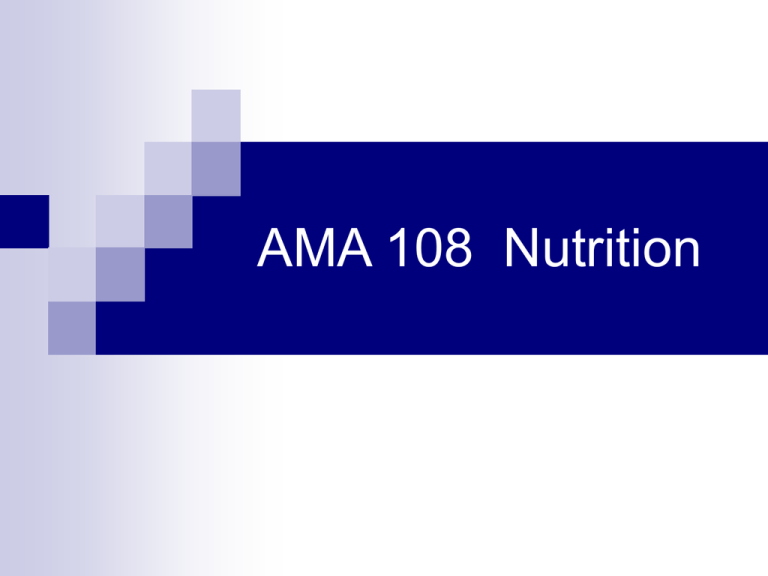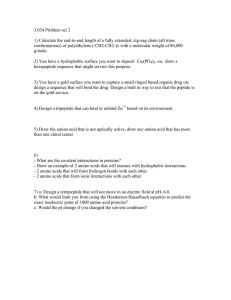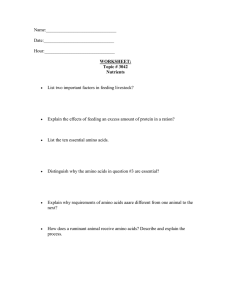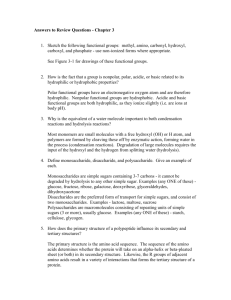AMA 108 Nutrition
advertisement

AMA 108 Nutrition Essentials of Nutrition Nutrients – essential elements found in food: Carbohydrates – provide body with energy - simple: sugars, not good for you - complex: starches, have most energy, found in legumes, grains, fruit and vegetables Proteins – contain amino acids, provide energy, help build and repair tissues and assist with antibody production; found in meat, cheese and eggs. The body needs 20 amino acids, 11 are produced by the body, the other 9 are called essential amino acids and you must get them from food Fats - lipids – concentrated source of heat production and energy, provide essential fatty acids. If body has inadequate supply of glucose to break down for energy, it will catabolize fat. Fat cushions and protects body organs and helps sustain body temp and cell function. Vitamins – organic substances that help break down proteins, carbohydrates and fats. Categorized as fat soluble or water soluble. Fat soluble are stored in liver, can’t take too much. Water soluble are excreted, take daily. Nutrients cont… Minerals – inorganic substances used in the formation of hard and soft body tissue. Necessary for muscle contraction, nerve conduction and blood clotting. - Major Minerals: sodium, potassium, calcium, phosphorous, magnesium, iron and iodine - Trace Minerals: fluorine, zinc, copper, cobalt and chromium Cholesterol – found only in animal products; body creates its own supply, low cholesterol diet recommended Lipoproteins – lipids and proteins that transport cholesterol between liver and arterial walls. Not created by found, already found in body. - LDL – low density lipoprotein: transports cholesterol to artery walls, too much causes plaque formation - HDL – high density lipoprotein: transports cholesterol away from artery walls, good kind to have Fiber – helps with elimination of waste. Found in vegetables, fruit and whole grains Amino Acids The Amino Acids (For each amino acid, both the three-letter and single-letter codes are given. CLICK the NAME to see the structural formula)Alanine Ala A hydrophobic Arginine Arg R free amino group makes it basic and hydrophilic Asparagine Asn N carbohydrate can be covalently linked ("N-linked) to its NH Aspartic acid Asp D free carboxyl group makes it acidic and hydrophilic Cysteine Cys C oxidation of their sulfhydryl (-SH) groups link 2 Cys (S-S) Glutamic acid Glu E free carboxyl group makes it acidic and hydrophilic Glutamine Gln Q moderately hydrophilic Glycine Gly G so small it is amphiphilic (can exist in any surroundings) Histidine His H basic and hydrophilic Isoleucine Ile I hydrophobic Leucine Leu L hydrophobic Lysine Lys K strongly basic and hydrophilic Methionine Met M hydrophobic Phenylalanine Phe F very hydrophobic Proline Pro P causes kinks in the chain Serine Ser S carbohydrate can be covalently linked ("Olinked") to its -OH Threonine Thr T carbohydrate can be covalently linked ("O-linked") to its -OH Tryptophan Trp W scarce in most plant proteins Tyrosine Tyr Y a phosphate or sulfate group can be covalently attached to its -OH Valine Val V hydrophobic Amino Acids cont… The Essential Amino Acids: Histidine Isoleucine Leucine Lysine Methionine (and/or cysteine) Phenylalanine (and/or tyrosine) Threonine Tryptophan Valine Digestion and Metabolism Digestion – physical and chemical breakdown of food into substances the body can use. Metabolism – change that food goes through after it is absorbed into the bloodstream - Anabolism: constructive phase where smaller molecules are converted to larger; i.e. amino acids convert to proteins - Catabolism: destructive phase where larger molecules are converted to smaller; i.e. glycogen converts to pyruvic acid. This process releases energy for cell growth and heat production; measured in calories Nutritional Guidelines US Department of Health and Human Services (DHHS), US Department of Agriculture (USDA), National Academy of Sciences, Food and Nutrition Board: all involved in making guidelines for healthy diet My Pyramid: food guidance system; five main food groups; a person’s age, gender and level of physical activity are all considered in determining the appropriate number of daily servings from each food group – study the info in the text 1. Grains 2. Vegetables 3. Fruits 4. Milk 5. Meat and Beans Food Pyramid Food Labels Nutritional Labeling and Education Act – 1990 Info required to be listed on package Regulated by FDA Know how to read and how to teach patients to read Nutrition and Health Therapeutic Nutrition- diet restrictions due to medical conditions; facilitates healing and influences blood components such as cholesterol and glucose Physical Fitness – endurance, flexibility and strength; healthy diet and regular exercise. Produces endorphins Weight Management – obesity is problem in US. Excess body fat causes health risks Physiologic Issues – Basal metabolic rate = how many calories body uses to perform basic functions. Level of physical energy. Thermic effect = energy body uses to digest food. Body Mass Index – ratio of fat to body mass. Sociologic and Psychological Issues – how we use food other than for energy; i.e. emotional eaters, socially etc.. Resources http://www.seekwellness.com/nutrition/disease.htm http://www.cdc.gov/nccdphp/dnpa/nutrition/index.htm http://www.nutrition.gov/nal_display/index.php?info_center=11&tax_level=1 http://www.mypyramid.gov/ http://www.sciencedaily.com/news/health_medicine/nutrition/ http://www.nlm.nih.gov/medlineplus/nutrition.html






